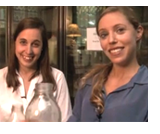| |

 Faculty members at the Universiti Teknologi Malaysia have developed the first two video lessons from that country to be up on the MIT BLOSSOMS website. Dr. Zaleha Abdullah presents the lesson, “Is there a Connection between Computer Network Topologies and a Malaysian Wedding?” This lesson provides a creative and culturally interesting introduction to designing a network topology. The second lesson, “Save Our Kingdom”, developed by Drs. Johari Surif and Mahani Mokhtar, teaches students about the often misunderstood Law of Conservation of Mass. This concept is creatively conveyed through the presentation of a Malaysian folktale in which a kingdom is saved by the correct answers to several difficult questions. Faculty members at the Universiti Teknologi Malaysia have developed the first two video lessons from that country to be up on the MIT BLOSSOMS website. Dr. Zaleha Abdullah presents the lesson, “Is there a Connection between Computer Network Topologies and a Malaysian Wedding?” This lesson provides a creative and culturally interesting introduction to designing a network topology. The second lesson, “Save Our Kingdom”, developed by Drs. Johari Surif and Mahani Mokhtar, teaches students about the often misunderstood Law of Conservation of Mass. This concept is creatively conveyed through the presentation of a Malaysian folktale in which a kingdom is saved by the correct answers to several difficult questions.
 The newest BLOSSOMS lesson from MIT introduces students to the “Tragedy of the Commons”, an extended metaphor in which shared resources are compared to a common grazing pasture, or “commons,” where any dairy farmer can graze as many cows as he/she wishes. If too many cows are added to the commons, they will overeat the grass in the pasture, and the shared resource will become depleted – a disadvantage to everyone. Students examine this issue of shared resources using basic math to frame the problem and will discover how useful this approach can be in considering consequences of various actions. Most importantly, they will become comfortable with problems of shared resources, learning how to recognize and seek out examples all around them. This lesson was developed by Abby Horn and Maite Peña-Alcaraz, Ph.D. students in MIT’s Engineering Systems Division. It has an accompanying animation that allows students to explore the "Tragedy of the Commons" problem in depth. Visit animation here. The newest BLOSSOMS lesson from MIT introduces students to the “Tragedy of the Commons”, an extended metaphor in which shared resources are compared to a common grazing pasture, or “commons,” where any dairy farmer can graze as many cows as he/she wishes. If too many cows are added to the commons, they will overeat the grass in the pasture, and the shared resource will become depleted – a disadvantage to everyone. Students examine this issue of shared resources using basic math to frame the problem and will discover how useful this approach can be in considering consequences of various actions. Most importantly, they will become comfortable with problems of shared resources, learning how to recognize and seek out examples all around them. This lesson was developed by Abby Horn and Maite Peña-Alcaraz, Ph.D. students in MIT’s Engineering Systems Division. It has an accompanying animation that allows students to explore the "Tragedy of the Commons" problem in depth. Visit animation here.
 This university outreach program has online lesson plans and scientific animations on the following topics: Exploring Biodiversity; Physiology; Microbiology; Regenerative Biology; Evolution; Neurobiology; Immunology; and the Biology of Cancer. The site also presents two remarkable biological animations – one on “The Inner Life of the Cell” and the other on “Mitochondria.” A final excellent resource found on this site is the Scientist Lecture Series, “Exploring Genomics and Epigenetics”. Links to these three resources can be found here. This university outreach program has online lesson plans and scientific animations on the following topics: Exploring Biodiversity; Physiology; Microbiology; Regenerative Biology; Evolution; Neurobiology; Immunology; and the Biology of Cancer. The site also presents two remarkable biological animations – one on “The Inner Life of the Cell” and the other on “Mitochondria.” A final excellent resource found on this site is the Scientist Lecture Series, “Exploring Genomics and Epigenetics”. Links to these three resources can be found here.
|
|
|
|